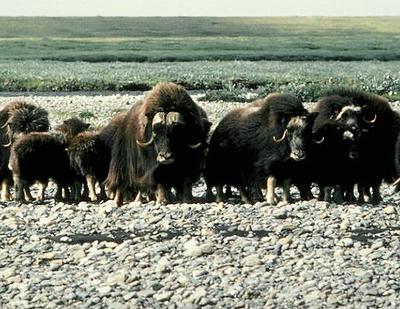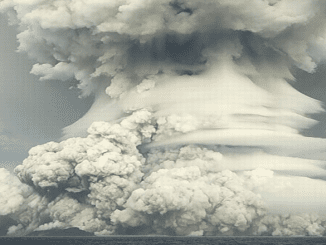
WASHINGTON, DC, August 17, 2020 (ENS) – The Trump administration completed plans Monday to open the Arctic National Wildlife Refuge to oil and gas drilling, a move that will permit natural resource exploitation in the core of one of America’s most treasured wild areas.
Gray wolves, musk oxen, caribou, and imperiled polar bears roam the Arctic National Wildlife Refuge’s 19.6 million acres. Migratory birds fly in from all 50 states and six continents. These lands are vital to the culture and survival of Indigenous people, who have relied on the area for thousands of years.

Regardless, U.S. Interior Secretary David Bernhardt today signed a Record of Decision approving the Coastal Plain Oil and Gas Leasing Program in the Arctic National Wildlife Refuge, ANWR, in Alaska.
The question of whether to drill for oil in the Arctic National Wildlife Refuge has been an ongoing political controversy in the United States since 1977. As of 2017, Republicans had attempted to allow drilling in ANWR almost 50 times, finally being successful with the passage of the Tax Cuts and Jobs Act of 2017.
The ANWR leasing program is required by law in the Tax Cuts and Jobs Act, which was passed by Congress and signed into law by President Donald Trump on December 22, 2017. The decision determines where and under what terms and conditions leasing will occur in the 1.56 million-acre Coastal Plain within the 19.3 million-acre ANWR.
“Congress directed us to hold lease sales in the ANWR Coastal Plain, and we have taken a significant step in meeting our obligations by determining where and under what conditions the oil and gas development program will occur,” said Bernhardt.
“Our program meets the legal mandate that Coastal Plain leaseholders get the necessary rights-of-way, easements and land areas for production and support facilities they need to find and develop these important Arctic oil and gas resources,” Bernhardt said.
Under the 2017 law, the federal government must conduct two lease sales of 400,000 acres each by December 2024.
Conservation groups and some native tribes say they will fight the Trump drilling plan in court.

The Gwich’in, a First Nations people of Canada and an Alaska Native people, generations of whom have relied upon the caribou migration across ANWR for food and clothing, plans to sue Trump officials over this decision.
About 9,000 Gwich’in live in 15 small communities in the Northwest Territories and the Yukon Territory of Canada, and in northern Alaska.
The Gwich’in refer to the ANWR coastal plain as “The Sacred Place Where Life Begins” because it is critical to their food security and way of life.
Gwich’in Steering Committee Executive Director Bernadette Demientieff said, “We are not giving up. This administration has done nothing but disrespect the Indigenous peoples that have occupied these lands. Our ways of life, our food security, and our identity is not up for negotiation. The fight is not over.”
“We have attorneys on this case and the courts will get to hear about the corrupt and illegal ways the Trump administration has used to open the Sacred Place Where Life Begins for drilling,” Demientieff said.
From New York City, where the Wildlife Conservation Society, WCS, manages the city’s aquarium and four zoos, President and CEO Cristián Samper today said, “At WCS, we stand strongly against the Administration’s announcement to approve an oil leasing program for the Arctic National Wildlife Refuge in Alaska. Oil and gas drilling in one of our last remaining wilderness areas is a direct hit against our country’s natural heritage. We ask Congress to take action to stop this development.”
“WCS science for more than 50 years has clearly shown that Arctic Refuge contains rare biodiversity that will be damaged by oil and gas development, including polar bears, caribou, muskoxen, wolverines, Arctic foxes, lemmings, gyrfalcons, ptarmigans, and a vast internationally-relevant assemblage of migratory birds,” Samper said.
“Scientists have documented in this 31,000 square miles of wilderness more than 700 kinds of plants and a multitude of different species: 200 bird, 47 mammal and 42 fish species. As nature in this pristine area already faces the effects of the climate crisis, we have an obligation as stewards of the environment to identify and arrest those cumulative effects that will be brought on by oil and gas development,” explained Samper.
“We can’t be shortsighted about opening up the Arctic Refuge to oil and gas development and forever lose this natural treasure of the United States,” he said.

Alaska’s elected officials, Republicans all, take the opposite view from that of Samper. They are pleased with the Trump administration’s two-part move – first the Tax Cuts and Jobs Act of 2017 and now the decision that law requires to drill in the Arctic National Wildlife Refuge.
Alaska Governor Michael Dunleavy has his eye on what he estimates are “between 4.3 and 11.8 billion barrels of technically recoverable oil reserves.
“Alaska plays a critical role in our Nation’s energy security,” said Dunleavy. “The vision of Secretary Bernhardt and President Donald J. Trump will lead to the responsible development of Alaska’s abundant resources, create new jobs, support economic growth and prosperity, and most importantly, retain well into the future Alaska’s critical role in our nation’s energy policy.”
Alaska Senator Lisa Murkowski called the move, “a capstone moment in our decades-long push to allow for the responsible development of a small part of Alaska’s 1002 Area.”
“I appreciate the significant work of Secretary Bernhardt and his team to get us to this point. I’m confident the ROD has been developed carefully and comprehensively and look forward to the lease sales mandated by law,” Murkowski said.
Under the approved oil and gas leasing plan, part of the Coastal Plain Oil and Gas Leasing Program area will be subject to no surface occupancy restrictions (359,400 acres) and operational timing limitations (585,400 acres) to protect habitat and wildlife.

All permitted activities will incorporate required operating procedures and stipulated restrictions based on what the Trump administration calls “the best science and technology to ensure that energy development does not come at the expense of the environment.”
The Bureau of Land Management received almost two million public comments, each of which the agency claims was considered in developing an environmentally responsible plan for the oil and gas development program. More than 70 specialists contributed their expertise to the analysis.
Alaska Congressman Don Young, a Republican, is backing the move to open ANWR. “As we approach the day where the first drilling rigs arrive and crude starts flowing,” he said, “I will continue working with great excitement to ensure that Alaska is front and center as we blaze the trail toward American energy dominance.”
But despite the Record of Decision signed today, the path is not clear yet for the oil and gas industry to move into ANWR.
For one thing, two dozen major banks around the world – including five of the six largest U.S. banks – have all prohibited financing for Arctic drilling. The Natural Resources Defense Council is asking Congress to take action to stop the leasing, and the plan is certain to face at least one court case.
Copyright Environment News Service (ENS) 2020. All rights reserved.



